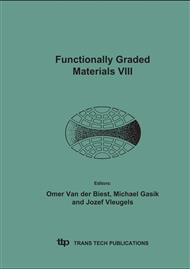p.471
p.477
p.483
p.489
p.495
p.501
p.507
p.517
p.523
Creep Response of Ceramic/Metal Functionally Graded Thermal Barrier Coating
Abstract:
The functionally graded thermal barrier coating (TBC) serves in high temperature and/or high temperature gradient environment for a long time. According to the experimental and theoretical research, in the metal substrate and the metal-rich interlayer creep deformation will appear under high temperature environment. In order to design and optimize the compositional distribution of FGM, it is necessary to analyze the stress and strain responses taking into account the creep phenomenon of the materials. In this article, the thermo-mechanical responses of ceramic/metal functionally graded TBC in work environment are analyzed by a finite element method. The creep phenomenon of the metal and the interlayers are taken into account. The numerical results indicate that the creep behavior of all interlayers, even for the ceramic-rich interlayer, cannot be neglected in analysis. It is suggested that the creep phenomenon of the material is important in the functionally graded TBC systems.
Info:
Periodical:
Pages:
495-500
Citation:
Online since:
August 2005
Authors:
Price:
Сopyright:
© 2005 Trans Tech Publications Ltd. All Rights Reserved
Share:
Citation:


